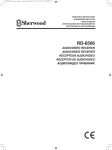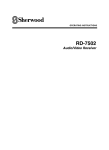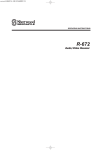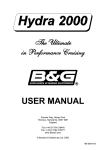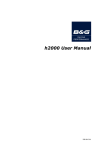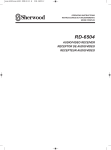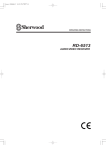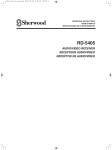Download Sherwood RD-5503 Operating instructions
Transcript
OPERATING INSTRUCTIONS
RD-5503
SURROUND RECEIVER
Introduction
This symbol is intended to alert the user to the
presence of uninsulated "dangerous voltage" within the
product's enclosure that may be of sufficient magnitude
to constitute a risk of electric shock to persons.
CAUTION
: TO REDUCE THE RISK OF ELECTRIC SHOCK, DO
NOT REMOVE COVER (OR BACK).
NO USER-SERVICEABLE PARTS INSIDE. REFER
SERVICING TO QUALIFIED SERVICE PERSONNEL.
This symbol is intended to alert the user to the
presence of important operating and maintenance
(servicing) instructions in the literature accompanying
the appliance.
WARNING : TO REDUCE THE RISK OF FIRE OR ELECTRIC SHOCK, DO NOT EXPOSE THIS APPLIANCE TO RAIN OR MOISTURE.
Caution regarding installation
Note : For heat dispersal, do not install this unit in a confined space such as
a bookcase or similar enclosure.
Do not block ventilation openings or stack other equipment on the top.
FOR YOUR SAFETY
EUROPE
AUSTRALIA
220 V
240 V
Units shipped to Australia are designed for operation on 230 V AC only.
To ensure safe operation, the three-pin plug supplied must be inserted only into a standard three-pin power point
which is effectively earthed through the normal household wiring. Extension cords used with the equipment must
be three-core and be correctly wired to provide connection to earth.
Improper extension cords are a major cause of fatalities. The fact that the equipment operates satisfactorily
does not imply that the power point is earthed and that the installation is completely safe. For your safety, if
in any doubt about the effective earthing of the power point, consult a qualified electrician.
PAN-EUROPEAN UNIFIED VOLTAGE
All units are suitable for use on supplies 220-240 V AC.
CAUTION
• Leave a space around the unit for sufficient ventilation.
• Avoid installation in extremely hot or cold locations, or in an area that is exposed to direct sunlight or heating equipment.
• Keep the unit free from moisture, water, and dust.
• Do not let foreign objects in the unit.
• The ventilation should not be impeded by covering the ventilation openings with items, such as newspapers, table-cloths, curtains, etc.
• No naked flame sources, such as lighted candles, should be placed on the unit.
• Please be care the environmental aspects of battery disposal.
• The unit shall not be exposed to dripping or splashing for use.
• No objects filled with liquids, such as vases, shall be placed on the unit.
• Do not let insecticides, benzene, and thinner come in contact with the set.
• Never disassemble or modify the unit in any way.
Notes on the AC power cord and the wall outlet.
• The unit is not disconnected from the AC power source(mains) as long as it is connected to the wall outlet, even if the unit has been
turned off.
• To completely disconnect this product from the mains, disconnect the plug from the wall socket outlet.
• When setting up this product, make sure that the AC outlet you are using is easily acceptable.
• Disconnect the plug from the wall outlet when not using the unit for long periods of time.
Note on recycling
This product’s packaging materials are recyclable and can be reused. Please dispose of any materials in accordance with
the local recycling regulations.
When discarding the unit, comply with local rules or regulations.
Batteries should never be thrown away or incinerated but disposed of in accordance with the local regulations concerning
chemical waste.
This product and the accessories packed together constitute the applicable product according to the WEEE directive
except batteries.
2
ENGLISH
READ THIS BEFORE OPERATING YOUR UNIT
CONTENTS
Introduction
ENGLISH
• READ THIS BEFORE OPERATING YOUR UNIT ................................................................................................................. 2
System Connections ......................................................................................................................................................... 4
Front Panel Controls ......................................................................................................................................................... 8
Remote Controls ................................................................................................................................................................. 9
• REMOTE CONTROL OPERATION RANGE ....................................................................................................................... 10
• LOADING BATTERIES ....................................................................................................................................................... 10
Operations
• LISTENING TO A PROGRAM SOURCE ............................................................................................................................ 11
• SURROUND SOUND .......................................................................................................................................................... 14
• ENJOYING SURROUND SOUND ...................................................................................................................................... 15
• LISTENING TO RADIO BROADCASTS ............................................................................................................................. 20
• LISTENING TO RDS BROADCASTS (FM ONLY) .............................................................................................................. 22
( RDS Tuner (Regional Option for some countries in Europe, etc))
• RECORDING ....................................................................................................................................................................... 24
• OTHER FUNCTIONS .......................................................................................................................................................... 25
• USING DIFFERENT FUNCTIONS ON THE FRONT PANEL ............................................................................................. 26
System Setup .................................................................................................................................................................... 27
• SETTING THE SYSTEM .................................................................................................................................................... 29
• SETTING THE INPUT ......................................................................................................................................................... 31
• SETTING THE SPEAKER SETUP ...................................................................................................................................... 32
• SETTING THE CH LEVEL .................................................................................................................................................. 36
• SETTING THE PARAMETER ............................................................................................................................................. 38
Troubleshooting Guide ................................................................................................................................................... 40
Specifications .................................................................................................................................................................... 41
3
System Connections
3
6
2
4 1
5
1. CONNECTING ANTENNAS
• A 75Ω outdoor FM antenna may be used to further
improve the reception. Disconnect the indoor
antenna before replacing it with the outdoor one.
• Change the position of the FM indoor antenna until you
get the best reception of your favorite FM stations.
• Place the AM loop antenna as far as possible from the receiver, TV set, speaker cords and the AC
input cord and set it to a direction for the best reception.
• If the reception is poor with the AM loop antenna, an AM outdoor antenna can be used in place of
the AM loop antenna.
4
ENGLISH
• Please be certain that this unit is unplugged from the AC outlet before making any connections.
• Be sure to observe the color coding when connecting audio, video and speaker cords.
• Make connections firmly and correctly. If not, it can cause loss of sound, noise or damage to the receiver.
2. CONNECTING AUDIO/VIDEO COMPONENTS
ENGLISH
• The VIDEO 1/VIDEO 2 jacks may be connected to AUDIO jacks of video components such as DVD player, TV, etc..
• The TAPE IN/OUT jacks and the VIDEO 1 IN/OUT jacks can be connected to audio recording equipment such as a tape deck,
an MD recorder, etc..
VIDEO 2
DVD player, TV, etc.
VIDEO 1
DVD player, tape deck, MD recorder, etc.
3. CONNECTING DIGITAL INs
• The OPTICAL and the COAXIAL DIGITAL OUTs of the
components that are connected to CD and VIDEO 1 of this unit
can be connected to these DIGITAL INs.
• A digital input should be connected to the components such as a
CD player, LD player, DVD player, etc. capable of outputting
Dolby Digital or PCM format digital signals, etc.
• For details, refer to the operating instructions of the component
connected.
• When making the COAXIAL DIGITAL connection, be sure to use
a 75Ω COAXIAL cord, not a conventional AUDIO cord.
• All of the commercially available optical fiber cords cannot be
used for the equipment. If there is an optical fiber cord which
cannot be connected to your equipment, consult your dealer or
nearest service organization.
Note : Be sure to make either a OPTICAL or a COAXIAL DIGITAL connection on each component. (You don’t need to do
both.)
5
4. CONNECTING SUBWOOFER PRE OUT
ENGLISH
• To emphasize the deep bass sounds, connect a powered
subwoofer.
5. CONNECTING SPEAKERS
• Be sure to connect speakers firmly and correctly according to
the channel(left and right) and the polarity(+ and -). If the
connections are faulty, no sound will be heard from the
speakers, and if the polarity of the speaker connection is
incorrect, the sound will be unnatural and lack bass.
• For installing the speakers, refer to "Speaker placement" on
page 7.
• After installing the speakers, first adjust the speaker settings
according to your environment and speaker layout.
(For details, refer to "SETTING THE SPEAKER SETUP" on
page 32.)
Caution :
• Be sure to use the speakers with the impedance of 6 ohms or
above.
• Do not let the bare speaker wires touch each other or any
metal part of this unit. This could damage this unit and/or the
speakers.
6. AC INPUT CORD
• Plug the cord into a wall AC outlet.
6
Speaker placement
ENGLISH
Ideal speaker placement varies depending on the size of your
room and the wall coverings, etc. The typical example of
speaker placement and recommendations are as follows :
Front left and right speakers and center speaker
• Place the front speakers with their front surfaces as flush with
TV or monitor screen as possible.
• Place the center speaker between the front left and right
speakers and no further from the listening position than the
front speakers.
• Place each speaker so that sound is aimed at the location of
the listener’s ears when at the main listening position.
Surround left and right speakers
• Place the surround speakers approximately 1 meter (40
inches) above the ear level of a seated listener on the direct
left and right of them or slightly behind.
Subwoofer
• The subwoofer reproduces powerful deep bass sounds.
Place a subwoofer anywhere in the front as
desired.
1. TV or screen
2. Front left speaker
3. Front right speaker
4. Center speaker
5. Subwoofer
6. Surround left speaker
7. Surround right speaker
Notes :
• When using a conventional TV, to avoid interference with the
TV picture, use only magnetically shielded front left and right
and center speakers.
• To obtain the best surround effects, the speakers except the
subwoofer should be full range speakers.
7
Front Panel Controls
4
5
6
7
ENGLISH
3
1
2
8
9
10
11
12
1. POWER switch
2. POWER ON/STANDBY button
3. STANDBY indicator
4. FLUORESCENT DISPLAY
For details, see below.
5. REMOTE SENSOR
6. INPUT SELECTOR/MULTI CONTROL knob
7. MASTER VOLUME CONTROL knob
8. SURROUND MODE UP/DOWN (▶/◀) buttons
9. STEREO button
10. BAND button
11. MEMORY/ENTER button
12. MODE button
FLUORESCENT DISPLAY
1. Input, frequency, volume level,
operating information, etc.
2. Surround mode indicators
3. AUTO indicator
4. DIGITAL INPUT indicator
5. DIRECT indicator
6. Preset number, sleep time display
7. MEMORY indicator
8. PRESET indicator
9. SLEEP indicator
10. TUNED indicator
11. STEREO indicator
12. RDS indicators
(Regional option for Europe, etc.)
8
ENGLISH
Remote Controls
STANDBY button
POWER ON button
PRESET UP/DOWN(+/-) buttons
TUNING UP/DOWN(+/-) buttons
NUMERIC(0~9) buttons
MUTE button
SLEEP button
CHANNEL LEVEL button
TONE MODE button
VOLUME UP/DOWN( / ) buttons
SETUP button
TEST TONE button
CURSOR CONTROL( , , , ), ENTER
</SEARCH MODE, SELECT / > buttons
• The functions in "< >" are regional option
for Europe, etc.
DISPLAY button
DIMMER button
SOUND PARAMETER button
SURROUND MODE UP/DOWN( / ) buttons
STEREO button
DIGITAL/ANALOG MODE button
INPUT SELECTOR buttons
Note: Some input selector buttons(BT IN, EXT. IN, USB, VIDEO 3, AUX, F.AUX) and USB transport buttons(◀◀, ▶, , ▶▶,
, REPEAT/RANDOM) are not available for this unit.
9
ENGLISH
REMOTE CONTROL OPERATION RANGE
• Use the remote control unit within a range of about 7 meters (23
feet) and angles of up to 30 degrees aiming at the remote sensor.
LOADING BATTERIES
1. Remove the cover.
2. Load two batteries ("AAA" size, 1.5 V) matching the
polarity.
• Remove the batteries when they are not used for a
long time.
• Do not use the rechargeable batteries (Ni-Cd type).
10
Operations
ENGLISH
Note : Before operating this receiver, first set this unit as desired for optimum performance, doing the system setup
procedures. (For details, refer to "System Setup" on page 27.)
LISTENING TO A PROGRAM SOURCE
Before operation
• Enter the standby mode.
2. Select the desired input source.
• The STANDBY indicator lights up.
This means that the receiver is not
disconnected from the AC mains and a
small amount of current is retained to
support the operation readiness.
• To switch the power off, push the POWER
switch again.
• Then the power is cut off and the STANDBY
indicator goes off.
or
or
1. In the standby mode, turn the power on.
POWER
or
• Each time the POWER ON/STANDBY button on the front
panel is pressed, the receiver is turned on to enter the
operating mode or off to enter the standby mode.
• On the remote control, press the POWER ON button to
enter the operating mode or press the STANDBY button to
enter the standby mode.
• In the standby mode, if the INPUT SELECTOR button is
pressed or the INPUT SELECTOR/MULTI CONTROL
knob is rotated, the receiver is turned on automatically and
the desired input is selected.
• Each time the INPUT SELECTOR/MULTI CONTROL knob
is rotated , the input source changes as follows:
→ TUNER
CD
TAPE
VIDEO 1
VIDEO 2 ←
(Frequency display)
• Each time the BAND button on the front panel or the
TUNER button on the remote control is pressed, the band
changes as follows:
→ FM ST → FM MONO → AM
11
When CD, VIDEO 1 is selected as an input source
3. Select the digital or the analog input connected as
5. Adjust the (overall) volume.
or
DOWN
• Each time this button is pressed, the corresponding input
is selected as follows:
o(ptical)
c(oaxial)
A(nalog)
UP
6. To mute the sound.
Notes :
• When TUNER, TAPE or VIDEO 2 is selected as an input
source, the digital input cannot be selected.
• When the selected digital input is not connected, the
"DIGITAL" indicator flickers and the analog input is
automatically selected.
• The selected digital or analog input is automatically
assigned to the corresponding input source on the INPUT
setup menu. (For details, refer to "SETTING THE INPUT "
on page 31.)
• The sound from the component connected to the selected
digital input can be heard regardless of the selected input
source.
• “MUTE” will flicker.
• To resume the previous sound level, press it again.
4. Operate the selected component for playback.
• When playing back the program sources with surround
sound, refer to “ENJOYING SURROUND SOUND” on
page 15.
12
ENGLISH
desired.
Adjusting the tone (bass and treble)
7. Enter the tone mode.
8. Press the CURSOR LEFT(◀)/RIGHT(▶) buttons to
ENGLISH
select the desired tone mode.
• Each time these buttons are pressed, the tone mode is
selected as follows :
OFF : To listen to a program source without the tone effect.
("DIRECT" indicator lights up.)
ON : To adjust the tone for your taste.
("DIRECT" indicator goes off.)
• The tone mode is displayed for several seconds.
When the TONE is set to ON to adjust the tone (bass and treble).
9. Press the CURSOR UP(▲)/DOWN(▼) buttons to
10. Press the CURSOR LEFT(◀)/RIGHT(▶) buttons to
select the desired tone.
adjust the selected tone as desired.
• The tone level can be adjusted within the range of -10 ~
+10 dB.
• In general, we recommend the bass and treble to be
adjusted to 0 dB (flat level).
• Extreme settings at high volume may damage your
speakers.
• To complete tone adjustment, repeat the above steps 9
and 10.
• If the tone display disappears, start from the step 7 again.
• Each time these buttons are pressed, the tone is selected
as follows :
→ BASS ↔ TRBL (treble) ↔ TONE ON ←
13
SURROUND SOUND
Surround modes
• The following modes apply conventional 2-channel
signals such as digital PCM or analog stereo signals to
high performance Digital Signal Processor to recreate
sound fields artificially.
Dolby Digital
Dolby Digital is the multi-channel digital signal format
developed by Dolby Laboratories. Discs bearing the Dolby
Digital logo includes the recording of up to 5.1 channels of
digital signals, which can reproduce much better sound
quality, spatial expansion and dynamic range
characteristics than the previous Dolby Surround effect.
MATRIX
This mode reproduces a delayed signals from the surround
channels to emphasize the sense of expansion for music
sources.
Dolby Pro Logic II surround
This mode applies conventional 2- channel signals such as
digital PCM or analog stereo signals as well as Dolby
Surround signals, etc. to surround processing to offer
improvements over conventional Dolby Pro Logic circuits.
Dolby Pro Logic ll surround includes 2 modes as follows:
CHURCH
This mode provides the ambience of a church for baroque,
string orchestral or choral group music.
THEATER
• Dolby Pro Logic ll MOVIE
When enjoying movies, this mode allows you to further
enhance the cinematic quality by adding processing that
emphasizes the sounds of the action special effects.
This mode provides the effect of being in a movie theater
when watching a movie source.
HALL
This mode provides the ambience of a concert hall for
classical music sources such as orchestral, chamber
music, or an instrumental solo.
• Dolby Pro Logic ll MUSIC
When listening to music, this mode allows you to further
enhance the sound quality by adding processing that
emphasizes the musical effects.
STADIUM
This mode provides the expansive sound field to achieve
the true stadium effect when watching baseball or soccer
games.
Dolby Pro Logic
This mode expands any 2-channel sources(, including
Dolby Surround sources) for 4 channel(front left, center,
front right and surround) play back.
The surround channel is monaural, but is played through
two surround speakers.
Dolby, Pro Logic, and the double-D symbol are registered
trademarks of Dolby Laboratories.
14
ENGLISH
• This receiver incorporates a sophisticated Digital Signal Processor that allows you to create optimum sound quality and sound
atmosphere in your personal Home Theater.
ENGLISH
ENJOYING SURROUND SOUND
Notes:
• Before surround playback, first perform the speaker setup procedure, etc. on the SETUP menu for optimum performance.
(For details, refer to "SETTING THE SPEAKER SETUP" on page 32.)
• Even when the auto surround mode is selected and the same type of digital signal format is being input, the optimum
surround mode may vary depending on whether the speaker type is set to "N (None)" or not.
• When 96 kHz PCM digital signal is being input, only the stereo mode will be selected .
Select the desired surround mode
• Each time the SURROUND MODE UP/DOWN (▶, > /
◀, <) buttons are pressed, the surround mode changes
as follows :
Manual surround mode: You can select the desired of
(“AUTO” indicator
different surround modes
goes off.)
selectable for the signal being
input.
Auto surround mode: The optimum surround mode will
(“AUTO” indicator
be automatically selected
lights off.)
depending on the signal format
being input.
or
Signal format being input
Selectable surround mode
Dolby Digital 5.1 channel sources
[DOLBY DIGITAL, AUTO SURROUND] or <DOLBY DIGITAL>
Dolby Digital 2 channel sources
[DOLBY PLII MOVIE, DOLBY PLII MUSIC, DOLBY PRO LOGIC, AUTO SURROUND] or
<DOLBY DIGITAL>
PCM (2channel) sources,
[DOLBY PLII MOVIE, DOLBY PLII MUSIC, DOLBY PRO LOGIC, MATRIX, CHURCH, THEATER,
Analog stereo sources
HALL, STADIUM, AUTO SURROUND] or <STEREO>
• Depending on speaker setting, some surround modes can be selected or not as follows :
[ ] : Possible only when "CENTER" or/and "SURR (Surround)" is/are not set to "N (None)".
< > : Possible only when "CENTER" and "SURR (Surround)" are set to "N (None)".
To cancel the surround mode for stereo operation
• Depending on the signal format which is being input, either
the stereo mode or the 2CH downmix mode is selected.
• To cancel either the stereo mode or the 2CH downmix
mode, select the surround mode with using the
SURROUND MODE UP/DOWN (▶, > / ◀, <) buttons.
or
2CH downmix mode
• This mode allows the multi-channel signals encoded in Dolby Digital format to be mixed down into 2 front channels and
to be reproduced through only two front speakers.
15
When adjusting the sound parameters
1. Press the SOUND PARAMETER button.
3. Press the CURSOR LEFT(◀)/ RIGHT(▶) buttons to
adjust the selected parameter as desired.
• Then "NIGHT : ~ " (or "PANO : ~ ") is displayed for several
seconds.
• If the parameter mode disappears, press this button again.
When selecting the "NIGHT (Night mode)"
This function compresses the dynamic range of previously
specified parts of Dolby Digital sound track (with extremely
high volume) to minimize the difference in volume between
the specified and non-specified parts. This makes it easy to
hear all of the sound track when watching movies at night
at low levels. The night mode can be set in 11 steps from
0.0 to 1.0 (default value : 0.0).
Note : In some Dolby Digital softwares, the night mode
may not be valid.
2. Press the CURSOR UP(▲)/DOWN(▼) buttons to
select the desired parameter.
When selecting the "PANO (Panorama)" mode
This mode extends the front stereo image to include the
surround speakers for an exciting "wraparound" effect with
side wall imaging.
Select "OFF" or "ON"(default value: OFF).
When selecting the "C. WIDTH (Center width)"
control
This adjusts the center image so it may be heard only from
the center speaker, only from the left/right speakers as a
phantom image, or from all three front speakers to varying
degrees.
The control can be set in 8 steps from 0 to 7(default value :
3).
• Each time these buttons are pressed, the parameter mode
changes as follows:
→ "NIGHT" ↔ "PANO" ↔ "C.WIDTH" ↔ "DIMEN" ←
(Night mode)
(Panorama mode)
(Center width control)
(Dimension control)
• "NIGHT" can be selected only while playing digital signals
from Dolby Digital source.
• "PANO", "C.WIDTH" and "DIMEN" can be selected only
while listening in Dolby Pro Logic II Music mode.
When selecting the "DIMEN (Dimension)" control
This gradually adjusts the soundfield either towards the
front or towards the rear. The control can be set in 7 steps
from -3 to +3 (default value : 0).
4. Repeat the above steps 2 and 3 to adjust other parameters.
16
ENGLISH
• While playing digital signals from Dolby Digital program source or listening in Dolby Pro Logic II Music mode, you can
adjust their parameters for optimum surround effect.
Adjusting each channel level with test tone
• The volume level of each channel can be adjusted easily with the test tone function.
2. At each channel, adjust the level as desired until the
ENGLISH
1. Enter the test tone mode.
sound level of each speaker is heard to be equally
loud.
• You can select the desired channel with the CURSOR
UP(▲)/DOWN(▼) buttons.
• The test tone mode is displayed and will be heard from the
speaker of each channel for 2 seconds as follows:
→ FL → C → FR → SR → SL → SW
Front Left
Center
Front Right
Surround Right
Surround Left
3. Cancel the test tone function.
Subwoofer
• When the speaker setting is "N (None or No)", the test
tone of the corresponding channel is not available.
17
Adjusting the current channel level
ENGLISH
• After adjusting each channel level with test tone, adjust the channel levels either according to the program sources or to suit
your tastes.
• You can adjust the current channel levels as desired. These adjusted levels are just memorized into user’s memory ("CAL"),
not into preset memory("REF 1", "REF 2").
1. Press the CHANNEL LEVEL button.
• Then the memory mode ("CAL", etc.) is displayed for
several seconds.
• When the memory mode or channel level disappears,
press this button again.
2. Select the desired channel.
3. Adjust the level of the selected channel as desired.
• Each time these buttons are pressed, the corresponding
channel is selected as follows:
REF 1, 2 (or CAL)
FL
C
FR
<DD>
SW
SL
SR
• The LFE level can be adjusted within the range of -10~0
dB and other channel levels within the range of -15 ~ +15
dB.
• In general, we recommend the LFE level to be adjusted
to 0 dB. If the recommended levels seem too high, lower
the setting as necessary.
LFE level
< >: Only when the digital signals from Dolby Digital program
sources that include LFE signal are input, LFE level can be
displayed.
• Depending on the speaker settings ("N (None or No)") and
surround mode, etc., some channels cannot be selected.
4. Repeat the above steps 2 and 3 to adjust each channel level.
18
Memorizing the adjusted channel levels
ENGLISH
• You can memorize the adjusted channel levels into preset memory("REF 1", "REF 2") and recall the memorized whenever you
want.
1. After performing the steps 1 ~ 4 in "Adjusting the
2. Select the desired one of REF 1 and REF 2.
current channel level" procedure on page 18, press
the ENTER button.
• If the preset memory disappears, perform the above step
1 again.
• Then "1" of "REF 1" indication flickers for several seconds.
3. Confirm your selection.
• The adjusted channel levels have now been memorized
into the selected memory.
Recalling the memorized channel levels
1. Press the CHANNEL LEVEL button.
2. Select the desired one of REF 1 and REF 2.
• "CAL " (or "REF 1", etc.) is displayed for several
seconds.
• If the channel level mode display disappears, press this
button again.
• Then the channel levels memorized into the selected
preset memory are recalled.
19
LISTENING TO RADIO BROADCASTS
1. Select the desired band.
2. Press the TUNING UP(+)/DOWN(-) buttons for more
than 0.5 second.
or
• Each time this button is pressed, the band changes as
follows ;
→ FM ST → FM MONO → AM
("ST" lights up)
• The tuner will now search until a station of sufficient
strength has been found. The display shows the tuned
frequency and "TUNED".
• If the station found is not the desired one, simply repeat
this operation.
• Weak stations are skipped during auto tuning.
("ST" goes off)
• When FM stereo broadcasts are poor because of weak
broadcast signals, select the FM mono mode to reduce
the noise, then FM broadcasts are reproduced in
monaural sound.
Auto presetting
Manual tuning
• Manual tuning is useful when you already know the
frequency of the desired station.
• After selecting the desired band, press the TUNING UP(+)
/ DOWN(-) buttons repeatedly until the right frequency has
been reached.
• Auto presetting function automatically searches for FM
stations only and store them in the memory.
• While listening to radio broadcasts, press and hold down
the (MEMORY/) ENTER button for more than 2 seconds.
or
• Then "AUTO MEM" flickers and this receiver starts auto
presetting.
• Up to 30 FM stations can be stored.
Notes:
• FM stations of weak strength cannot be memorized.
• To memorize AM stations or weak stations, preform
"Manual presetting" procedure with using "Manual tuning"
operation.
20
ENGLISH
Auto tuning
Manual presetting
• You can store up to 30 preferred stations in the memory.
1. Tune in the desired station with auto or manual tuning.
3. Select the desired preset number (1~30) and press the
ENGLISH
ENTER button.
or
2. Press the ENTER button.
• When using the NUMERIC buttons on the remote control.
Examples) For “3” :
For “15” :
For “30” :
• The station has now been stored in the memory.
• When using the NUMERIC buttons, the station is stored
automatically without pressing the ENTER button.
• A stored frequency is erased from the memory by storing
another frequency in its place.
• If “MEM” goes off, start again from the above step 2.
MEM
DIRECT
• "MEM" is flickering for several seconds.
4. Repeat the above steps1 to 3 to memorize other stations.
MEMORY BACKUP FUNCTION
The following items, set before the receiver is turned off, are memorized.
• INPUT SELECTOR settings
• Surround mode settings
• Preset stations,etc.
Tuning to preset stations
• After selecting the tuner as an input source, select the desired preset number.
• When using the NUMERIC buttons on the remote control.
Examples) For “3” :
For “15” :
For “30” :
21
RDS Tuner (Regional Option for some countries in Europe, etc.)
RDS(Radio Data System) is a method for sending information signals together with the transmitter signals. Your tuner is
capable of translating these signals and putting the information on the display. These codes contain the following informations.
Program Service name (PS), A list of Program Types (PTY), Traffic Announcement (TA), Clock Time (CT), Radio Text (RT).
Note : In the other countries, RDS tuner function cannot be available.
RDS search
• Use this function to automatically search and receive the stations offering RDS services.
1. In the FM mode, select the RDS search mode.
2. When "RDS SRCH" is displayed, press the ENTER
button.
• Each time this button is pressed, the search mode
changes as follows;
→ RDS SRCH → TP SRCH → PTY SRCH → OFF
• The tuner automatically searches stations offering RDS
services and the station name is displayed.
• If no RDS station is found, "NO RDS" is displayed.
• When "RDS SRCH" is not displayed, repeat again from
the above step 1.
TP search
• Use this function to automatically search and receive the stations broadcasting the traffic program.
1. In the FM mode, press the SEARCH MODE button
2. When "TP SRCH" is displayed, press the ENTER button.
twice.
• "TP SRCH" is displayed.
• The tuner automatically searches for stations
broadcasting the traffic program.
• "NO TRAFF" is displayed if the signal is too weak or there
are no stations broadcasting the traffic program.
• When "TP SRCH" is not displayed, repeat again from the
above step 1.
22
ENGLISH
LISTENING TO RDS BROADCASTS(FM ONLY)
PTY search
• Use this function to automatically search and receive the stations broadcasting the desired program type.
ENGLISH
1. In the FM mode, press the SEARCH MODE button
2. When "PTY SRCH" is displayed, select the desired
three times.
program type.
• "PTY SRCH" is displayed.
• Each time these buttons are pressed, one of 32 different
types of programs is selected.
(NEWS, AFFAIRS, INFO, SPORT, EDUCATE, DRAMA,
CULTURE, SCIENCE, VARIED, POP M, ROCK M, EASY
M, LIGHT M, CLASSICS, OTHER M, WEATHER,
FINANCE, CHILDREN, SOCIAL, RELIGION, PHONE IN,
TRAVEL, LEISURE, JAZZ, COUNTRY, NATION M,
OLDIES, FOLK M, DOCUMENT, TEST, ALARM, NONE)
• When "PTY SRCH" is not displayed, repeat again from the
above step 1.
3. When the desired program is displayed, press the ENTER button.
• The tuner automatically searches a station offering PTY
services.
• If no station is found, "NO PROG" is displayed.
DISPLAY
• Each time this button is pressed, the display mode
changes as follows:
In the FM mode,
Program
→ Service name →
(PS)
Volume
←
Program
Type
(PTY)
Surround
mode
→
←
Clock
Time
(CT)
→
Frequency
Radio
Text
(RT)
←
• If the signals are too weak or no RDS service is available,
"NO NAME", "NO PTY", "NO TIME" or "NO TEXT" will be
displayed.
23
RECORDING
ENGLISH
• When recording the analog signals from CD or VIDEO 1, be sure to select the analog input.
(For details, refer to "When CD, VIDEO 1 is selected as an input source" on page 12.)
• The volume and tone (bass, treble) settings have no effect on the recording signals.
• When you select tuner, CD or VIDEO 2 as a recording source, recording may be made on TAPE, VIDEO 1 or both simultaneously.
Recording with TAPE
1. Select the desired input as a recording source except for TAPE.
or
or
2. Start recording on the TAPE.
3. Start play on the desired input.
Recording with VIDEO 1
• When the audio recording equipment is connected to the VIDEO 1 jacks, you can record the audio signals.
1. Select the desired input as a recording source except for VIDEO 1.
or
or
2. Start recording on the VIDEO 1.
3. Start play on the desired input.
24
OTHER FUNCTIONS
ENGLISH
Operating the sleep timer
• The sleep timer allows the system to continue to operate for a specified period of time before automatically shutting off.
• To set the receiver to automatically turn off after the specified period of time.
• Each time this button is pressed, the sleep time changes
as follows:
→ 10 → 20 → 30 → --- → 90 → OFF
Unit : minutes
• While operating the sleep timer, "
" lights up.
• When the sleep time is selected, the fluorescent display
is dimly lit.
Displaying the operation status
Adjusting the brightness of the fluorescent
display
During playback,
• Each time this button is pressed, the brightness of
the fluorescent display changes as follows:
→ ON → dimmer → OFF
• Each time this button is pressed, the display mode
changes as follows:
→
Surround
mode
→
Volume
→
Input
source
• In the display OFF mode, pressing any button will
restore the display ON mode.
• When RDS tuner function is available in your country, for
details on the FM mode information, see "DISPLAY" on
page 23.
25
USING DIFFERENT FUNCTIONS ON THE FRONT PANEL
• You can use the different functions easily with the specific buttons on the front panel.
2. Enter the selected mode.
o
• Depending on the selected input source, each time this
button is pressed, the mode changes as follows and is
displayed for several seconds:
→ [PRESET → TUNE → ] CH LEVEL
OFF ← TONE < ← D/A SET> ←
• The setting mode will be cancelled in several seconds.
Should this happened, perform the above step 1 again.
(Current input display)
[ ] : Selectable only when the tuner is selected.
< >: Selectable only when the CD or VIDEO 1 is selected.
3. Set the selected mode as desired.
When selecting “D/A SET” (Digital/Analog input mode)
• Each time this knob is rotated, the digital(optical or
coaxial) or the analog input will be selected.(For details,
refer to “When CD, VIDEO 1 is selected as an input
source” on page 12.)
When selecting “TONE” (Tone adjustment mode)
• Each time this knob is rotated, the tone mode is selected
as follows:
OFF : To listen to a program source without the tone effect.
(“DIRECT” indicator lights up.)
ON : To adjust the tone for your taste.
(“DIRECT” indicator goes off.)
When selecting “PRESET” (Preset tuning mode)
• Each time this knob is rotated, the preset station will be
tuned to.(For details, refer to “Tuning to preset stations” on
page 21.)
When selecting “TUNE” (Auto/manual tuning mode)
• Depending on whether this knob is rotated over several
steps once or one by one slowly, Auto tuning or manual
tuning will function. (For details, refer to “Auto tuning” and
“Manual tuning” on page 20.)
◆When the TONE is set to ON to adjust the tone
(bass and treble)
① Press the MODE button to select the desired tone.
② Rotate this knob to adjust the selected tone as desired.
③ To complete tone adjustment, repeat the above steps ①
and ②.
When selecting “CH LEVEL” (Channel level adjustment mode)
• You can adjust the current channel levels as desired.
(For details, refer to “Adjusting the current channel level” on
page 18.)
① Press the MODE button to select the desired channel.
② Rotate this knob to adjust the level of the selected channel
as desired.
③ Repeat the above steps ① and ② to adjust each channel
level.
4. Exit the setting mode.
o
26
ENGLISH
1. Select the desired setting mode.
ENGLISH
System Setup
• The setup menu is displayed on the fluorescent display and allows you to perform the setup procedures easily. In most
situations, you will only need to set this once during the installation and layout of your home theater, and it rarely needs to be
changed later.
The setup menu consists of 5 main menus ; system, input, speaker setup, CH level and parameter. These menus
are then divided up into various sub-menus.
1. Turn the setup menu on.
2. Select the desired menu using the CURSOR UP(▲)/
DOWN(▼) buttons.
• The setup menu will be shown.
• To turn the menu off, press this button again.
3. Confirm your selection.
• When selecting "SYSTEM", see "SETTING THE
SYSTEM" on page 29.
• When selecting "INPUT", see "SETTING THE INPUT" on
page 31.
• When selecting "SPK SET", see "SETTING THE
SPEAKER SETUP" on page 32.
• When selecting "CH LEVEL", see "SETTING THE CH
LEVEL" on page 36.
• When selecting "PARAMTR", see "SETTING THE
PARAMETER" on page 38.
• When selecting "EXIT", the setup menu will be turned off.
27
Setup menu flow
ENGLISH
• The setup menu flow is as follows :
• When "RETURN" is selected on a sub-menu, it will returns to the previous menu.
Note : During setup menu operation, only the (POWER ON/) STANDBY button and the buttons required for system setup
will function.
28
ENGLISH
SETTING THE SYSTEM
• SW (SUBWOOFER) : To select the desired subwoofer mode.
• TONE : To adjust the tone (bass and treble) as desired.
• RETURN : To return to the previous menu.
1. Press CURSOR UP(▲)/DOWN(▼) buttons to select
2. Press the CURSOR LEFT(◀)/RIGHT(▶) buttons to
the desired item.
set the selected item as desired
When selecting the SUBWOOFER mode
• "SW +" mode is effective only when "FRONT", "CENTER" or "SURR" is set to "L" and "SUB- W" is set to "Y" on the SPK
SET menu. (For details, refer to "SETTING THE SPEAKER SETUP" on page 32.)
• While playing the 2 channel source in MATRIX, CHURCH, THEATER, HALL or STADIUM mode, the low frequency signals
can be reproduced from subwoofer regardless of the subwoofer mode setting.
NORM : When the low frequency signals of channels set to "L" are reproduced from those channels only.
In this mode, the low frequency signals that are reproduced from the subwoofer channel is only the low frequency
signals of LFE (from the multi-channel sources that contains LFE (Low Frequency Effects) channel, also called the
".1" channel) and the channels set to "S".
SW +: When the low frequency signals of channels set to "L" are reproduced simultaneously from those channels and the
subwoofer channel.
In this mode, the low frequency range expands more uniformly through the room, but depending on the size and
shape of the room, interference may result in a decrease of the actual volume of the low frequency range.
29
When selecting the TONE
OFF : To listen to a program source without the tone effect. ("DIRECT" indicator lights up.)
When the TONE is set to ON to adjust the tone (bass and treble)
① Press the CURSOR UP(▲)/DOWN(▼) buttons to select the desired tone.
When selecting the BASS
② Press the CURSOR LEFT(◀)/RIGHT(▶) buttons to adjust the selected tone as desired.
• The tone level can be adjusted within the range of -10 ~
+10 dB.
• In general, we recommend the bass and treble to be
adjusted to 0 dB (flat level).
• Extreme settings at high volume may damage your
speakers.
• To complete tone adjustment, repeat the above steps ①
and ②.
30
ENGLISH
ON : To adjust the tone for your taste. ("DIRECT" indicator goes off.)
ENGLISH
SETTING THE INPUT
• D.IN (DIGITAL IN) : To assign the connected DIGITAL INs to the desired input.
• AUTO (AUTO SURROUND) : To select the auto surround mode or the manual surround mode.
• RETURN : To return to the previous menu.
1. Press the CURSOR UP(▲)/DOWN(▼) buttons to select the desired input source, then press the ENTER button.
Example) When selecting the CD
2. Press the CURSOR UP(▲)/DOWN(▼) buttons to
3. Press the CURSOR LEFT(◀)/RIGHT(▶) buttons to
select the desired item.
set the selected item as desired.
When selecting the DIGITAL IN
• You should assign the connected DIGITAL INs to the desired of CD and VIDEO 1.
(For details, refer to "CONNECTING DIGITAL INs" on page 5.)
• You can select the desired of OPT (optical), COAX(coaxial) and ANL (analog).
Notes :
• In such a case that a DIGITAL IN is assigned to two input sources or more, when these input sources are selected, the digital audio
signals can be heard from the same DIGITAL IN.
• When TUNER, TAPE or VIDEO 2 is selected as an input source, the digital input(“OPT”, “COAX”) cannot be selected.
When selecting the AUTO SURROUND
• Depending on how to select a surround mode, you can select the auto surround mode or the manual surround mode.
OFF (Manual surround mode) : You can select the desired of different surround modes selectable for the signal being input with
using the SURROUND MODE UP/DOWN (▶, > /◀, <) buttons.
(For details, refer to "ENJOYING SURROUND SOUND" on page 15.)
ON (Auto surround mode) : The optimum surround mode will be automatically selected depending on the signal format being input.
Notes :
• Even when the auto surround mode is selected and the same type of digital signal format is being input, the optimum surround mode
may vary depending on whether the speaker type is set to "N (None)" or not.
• When 96 kHz PCM digital signal is being input, only the stereo mode will be selected.
31
SETTING THE SPEAKER SETUP
ENGLISH
• After you have installed this receiver and connected all the components, you should adjust the speaker settings for the
optimum sound acoustics according to your environment and speaker layout.
• Even when you change speakers, speaker positions, or the layout of your listening environment, you should adjust the
speaker settings, too.
• CONFIG (CONFIGURATION) : To select the sizes of the speakers that are connected.
• DISTANCE: To enter the distance between the listening position and each speaker to set the delay time automatically for
optimum surround playback.
• X-OVER (CROSSOVER) : To select the desired crossover frequency.
• RETURN : To return to the previous menu.
32
When selecting the CONFIGURATION
1. Press the CURSOR UP(▲)/DOWN(▼) buttons to
3. Press the CURSOR LEFT(◀)/ RIGHT(▶) buttons to
set the selected speaker as desired.
ENGLISH
select the "CONFIG", then press the ENTER button.
• Depending on your speaker type, you can select one of
these following speaker types.
L(Large): Select this when connecting speakers that can
fully reproduce sounds below crossover frequency.
S(Small) : Select this when connecting speakers that can
not fully reproduce sounds below crossover
frequency. When this is selected, sounds below
crossover frequency are sent to the subwoofer
or speakers which are set to "L (Large)" (when
not using a subwoofer)
N(None): Select this when no speakers are connected.
When this is selected, sounds are sent to the
speakers which are not set to "N (None)".
Y(Yes)/N(No): Select the desired depending on whether a
subwoofer is connected or not.
Notes :
• When speakers are set to "S (Small)", you should set
their crossover frequency correctly according to their
frequency characteristics. (For details, refer to "When
selecting the CROSSOVER" on page 35.)
• When "SUB-W" is set to "N (No)", "FRONT" is
automatically set to "L (Large)".
• When the "FRONT" is set to "S (Small)", "CENTER" and
"SURR" cannot be set to "L (Large)".
2. Press the CURSOR UP(▲)/DOWN(▼) buttons to
select the desired speaker.
4. Repeat the above steps 2 and 3 until the speakers are all set to the desired mode.
About the speaker size
• Select "L (Large)" or "S (Small)" not according to the actual size of the speaker but according to the speaker's capacity for
playing low frequency (bass sound below frequency set on the "X-OVER" menu) signals.
• If you do not know, try comparing the sound at both settings (setting the volume to a level low enough so as not to damage
the speakers) to determine the proper setting.
33
When selecting the DISTANCE
ENGLISH
1. Press the CURSOR UP(▲)/DOWN(▼) buttons to select the DISTANCE, then press the ENTER button.
2. Press the CURSOR UP(▲)/DOWN(▼) buttons to
3. Press the CURSOR LEFT(◀)/RIGHT(▶) buttons to
select the desired item.
set the selected item as desired.
Note :
When selecting the desired unit
• You cannot select the speakers set to "N (None or No)".
• You can select either "M (Meter)" or "FT (Feet)".
• Once a unit is selected, the distances are automatically
changed in the selected unit.
When setting the distance
• You can set the distance within the range of 0.0 ~ 9.0
meters in 0.3 meter intervals (or 0 ~ 30 feet in 1 feet
intervals).
4. Repeat the above steps 2 and 3 until the distances are all set as desired.
About the speaker distance
When enjoying multi-channel surround playback with Dolby Digital sources, etc., it is ideal that the center, surround and
subwoofer speakers should be the same distance from the main listening position as the front speakers. By entering the distance
between the listening position and each speaker, the delay times of center, surround and subwoofer speakers are automatically
adjusted to create an ideal listening environment virtually as if the center, surround and subwoofer speakers were at their ideal
locations respectively.
34
When selecting the CROSSOVER
ENGLISH
• When speakers are set to "S (Small)", be sure to set their crossover frequency correctly according to their frequency
characteristics.
1. Press the CURSOR UP(▲)/DOWN(▼) buttons to
2. Press the CURSOR LEFT(◀)/RIGHT(▶) buttons to
select the "X-OVER", then press the ENTER button.
set the crossover frequency as desired.
• You can adjust the crossover frequency within the range
of 40 ~ 200 Hz in 10 Hz intervals.
About the crossover frequency
• When speakers are set to "S (Small)", low frequencies in
those channels that are below the crossover frequency
are to output from subwoofer or front speakers which are
set to "L (Large)" (when not using a subwoofer).
• Refer to the operating instructions of the speakers to be
connected. If the frequency range of your speaker is 100
Hz~20 kHz, the crossover frequency should be set to 100
Hz(or slightly higher).
35
ENGLISH
SETTING THE CH LEVEL
Note : Depending on the speaker settings ("N (None or No)"), some channels cannot be selected.
Adjusting the current channel level
• You can adjust the current channel levels as desired. These adjusted levels are just memorized into user’s memory("CAL"),
not into preset memory ("REF 1", "REF 2")
• After adjusting each channel level with test tone, adjust the channel levels either according to the program sources or to suit
your tastes. (For details, refer to "Adjusting each channel level with test tone" on page 17.)
1. Press the CURSOR UP(▲)/DOWN(▼) buttons to select the desired channel.
Example) When selecting Dolby Digital source's LFE
2. Press the CURSOR LEFT(◀)/RIGHT(▶) buttons to
3. Repeat the above steps 1 and 2 to adjust each
adjust the level of the selected channel or program
source's LFE as desired.
channel level.
• The LFE level can be adjusted within the range of -10 ~ 0
dB and other channel levels within the range of -15 ~ +15 dB
• In general, we recommend the LFE level to be adjusted to
0 dB. If the recommended levels seem too high, lower
setting as necessary.
36
Memorizing the adjusted channel levels
ENGLISH
• You can memorize the adjusted channel levels into preset memory("REF 1", "REF 2") and recall the memorized whenever you
want.
1. After performing the steps 1 ~ 3 in "Adjusting the
2. Press the CURSOR LEFT(◀)/RIGHT(▶) buttons to
current channel level" procedure on page 36, press
the ENTER button.
select the desired preset memory, then press the
ENTER button.
• Each time the CURSOR LEFT(◀) or RIGHT(▶) button is
pressed, "REF 1" or "REF 2" is selected.
• The adjusted channel levels have now been memorized
into the selected memory.
• Then "1" of "REF 1" indication flickers.
Recalling the memorized channel levels
1. Press the CURSOR UP(▲)/DOWN(▼) buttons to
2. Press the CURSOR LEFT(◀)/RIGHT(▶) buttons to
select the "MODE ~ ".
select the desired one of REF 1 and REF 2.
• Then the channel levels memorized into the selected
preset memory are recalled.
• "CAL" may be displayed instead of "REF 1" or "REF 2".
37
ENGLISH
SETTING THE PARAMETER
• NIGHT M (NIGHT MODE) : To adjust the dynamic range compression that makes faint sound easier to hear at low volume
levels.
• PLII MSC (DOLBY PLII MUSIC) : To adjust the various surround parameters for optimum surround effect.
• RETURN : To return to the previous menu.
When selecting the NIGHT MODE
• This function compresses the dynamic range of previously specified parts of Dolby Digital sound track (with extremely high
volume) to minimize the difference in volume between the specified and non-specified parts.
This makes it easy to hear all of the sound track when watching movies at night at low levels.
Notes:
• The night mode setting is valid only when the digital signals from Dolby Digital program source are being input.
• In some Dolby Digital softwares, the night mode setting may not be valid.
1. Press the CURSOR UP(▲)/DOWN(▼) buttons to
2. Press the CURSOR LEFT(◀)/ RIGHT(▶) buttons to
select the "NIGHT M", then press the ENTER button.
adjust the dynamic range compression as desired.
0.0
0.1
0.2 ........ 0.9
Lower compression
38
1.0
Higher compression
When selecting the DOLBY PLII MUSIC
ENGLISH
• You can adjust the various surround parameters for optimum surround effect.
Note: The parameter settings are valid only when listening in Dolby Pro Logic II Music mode.
1. Press the CURSOR UP(▲)/DOWN(▼) buttons to
3. Press the CURSOR LEFT(◀)/ RIGHT(▶) buttons to
select the "PLII MSC", then press the ENTER button.
adjust the selected parameter as desired.
When selecting the "PANO (Panorama)" mode
This mode extends the front stereo image to include the
surround speakers for an exciting "wraparound" effect with
side wall imaging. Select "OFF" or "ON"(default
value:OFF).
When selecting the "C. WIDTH (Center width)"
control
This adjusts the center image so it may be heard only from
the center speaker, only from the left/right speakers as a
phantom image, or from all three front speakers to varying
degrees. The control can be set in 8 steps from 0 to 7
(default value : 3).
2. Press the CURSOR UP(▲)/DOWN(▼) buttons to
select the desired parameter.
When selecting the "DIMEN (Dimension)"
control
This gradually adjusts the soundfield either towards the
front or towards the rear. The control can be set in 7 steps
from -3 to +3 (default value : 0).
4. Repeat the above steps 2 and 3 to adjust other parameters.
39
Troubleshooting Guide
PROBLEM
POSSIBLE CAUSE
REMEDY
No power
• The AC input cord is disconnected.
• Poor connection at AC wall outlet or the
outlet is inactive.
• Connect the cord securely.
• Check the outlet using a lamp or another
appliance.
No sound
• The speaker cords are disconnected.
• The master volume is adjusted too low.
• The MUTE button on the remote control is
pressed to ON.
• Incorrect selection of the input source.
• Incorrect connections between the
components.
• Check the speaker connections.
• Adjust the master volume.
• Press the MUTE button to cancel the
muting effect.
• Select the desired input source correctly.
• Make connections correctly.
No sound from the surround
speakers
• Surround mode is switched off(stereo mode).
• Master volume and surround level are too
low.
• A monaural source is used.
• Surround speaker setting is “N”.
• Select a surround mode.
• Adjust master volume and surround level.
No sound from the center
speaker
• Surround mode is switched off(stereo mode).
• Center speaker setting is “N”.
• Master volume and center level are too low.
• Select the desired surround.
• Select the desired center speaker setting.
• Adjust master volume and center level.
Stations cannot be received
• No antenna is connected.
• The desired station frequency is not tuned
in.
• The antenna is in wrong position.
• Connect an antenna.
• Tune in the desired station frequency.
• An incorrect station frequency has been
memorized.
• The memorized stations are cleared.
• Memorize the correct station frequency.
Poor FM reception
• No antenna is connected.
• The antenna is not positioned for the best
reception.
• Connect an antenna.
• Change the position of the antenna.
Continuous hissing noise
during FM reception,
especially when a stereo
broadcast is received.
• Weak signals.
• Change the position of the antenna.
• Install an outdoor FM antenna.
Continuous or intermittent
hissing noise during AM
reception, especially at night.
• Noise is caused by motors, fluorescent
lamps or lightning, etc.
• Keep the receiver away from noise sources.
Remote control unit does not
operate.
• Batteries are not loaded or exhausted.
• The remote sensor is obstructed.
Preset stations cannot be
received
• Select a stereo or surround source.
• Select the desired surround speaker setting.
• Move the antenna and retry tuning.
• Memorize the stations again.
• Install an outdoor AM antenna.
40
• Replace the batteries.
• Remove the obstacle.
ENGLISH
If a fault occurs, run through the table below before taking your receiver for repair.
If the fault persists, attempt to solve it by switching the receiver off and on again. If this fails to resolve the situation, consult your
dealer. Under no circumstances should you attempt to repair the receiver yourself. This could void the warranty.
Specifications
ENGLISH
AMPLIFIER SECTION
• Power output, stereo mode, 6 Ω, THD 0.7%, 40 Hz~20 kHz
• Total harmonic distortion, 6 Ω, 50 W, 1 kHz
| 0.09 %
• Intermodulation distortion
60 Hz : 7 kHz= 4 : 1 SMPTE, 6 Ω, 50 W
| 0.1 %
|
2×50 W
• Input sensitivity, 47 kΩ
Line (CD, TAPE, VIDEO)
| 280 mV
• Signal to noise ratio, IHF “A” weighted
Line (CD, TAPE, VIDEO)
| 92 dB
• Frequency response
Line (CD, TAPE, VIDEO), 20 Hz~50 kHz
| +0 dB, -3 dB
• Output level
TAPE/VIDEO 1 REC, 2.2 kΩ
| 280 mV
• Bass/Treble control, 100 Hz/10 kHz
| ±10 dB
• Surround mode, only channel driven
Front power output, 6 Ω, 1 kHz, THD 0.7 %
| 70 W / 70 W
Center power output, 6 Ω, 1 kHz, THD 0.7 %
| 70 W
Surround power output, 6 Ω, 1 kHz, THD 0.7 %
| 70 W / 70 W
DIGITAL AUDIO SECTION
• Sampling frequency
| 32, 44.1, 48, 96 kHz
• Digital input level
Coaxial, 75 Ω
| 0.5 Vp-p
Optical, 660 nm
| -15~-21 dBm
FM TUNER SECTION
•
•
•
•
•
•
•
•
•
Tuning frequency range
| 87.5~108 MHz
Usable sensitivity, THD 3%, S/N 26 dB
| 12.8 dBf
46 dB quieting sensitivity, mono/stereo
| 20.2 / 45.3 dBf
Signal to noise ratio, 65 dBf, mono/stereo
| 55 / 50 dB
Total harmonic distortion, 65 dBf,1 kHz, mono/stereo
| 0.5 / 1.0 %
Frequency response, 30 Hz~12 kHz
| ±3.0 dB
Stereo separation, 1 kHz
| 30 dB
Capture ratio
| 4 dB
IF rejection ratio
| 80 dB
•
•
•
•
Tuning frequency range
| 522~1611 kHz
Usable sensitivity
| 500 µV/m
Signal to noise ratio
| 40 dB
Selectivity
| 25 dB
•
•
•
•
Power supply
| 230 V ~ 50 Hz
Power consumption
| 230 W
Dimensions (W×H×D, including protruding parts)
Weight (Net)
| 9.5 kg (20.9 lbs)
AM TUNER SECTION
GENERAL
|
440×141×358.5 mm (17-3/8×5-1/2×14-1/8 inches)
Note: Design and specifications are subject to change without notice for improvements.
41
RD-5503
SURROUND RECEIVER
5707-00000-125-0S












































